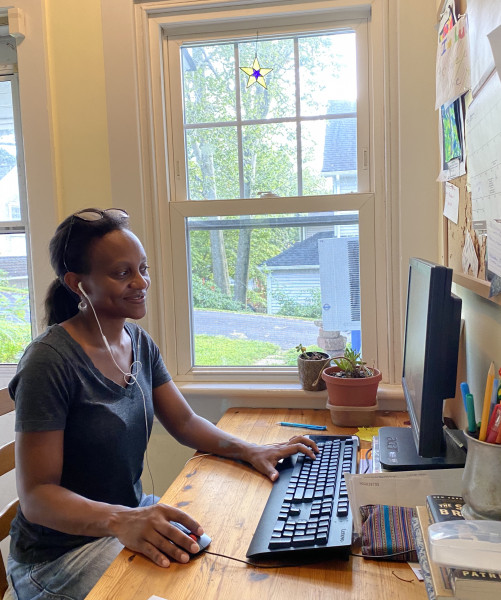
Above: Multimedia Producer Dave Rizzio in his dining room workspace
At first, working from home seemed exciting. Even furtive. Sleeping in a little. No commute. Having your own bathroom and fridge nearby. Sitting at the computer in your jammies. But as weeks of working in slippers turned into months, many of us had to get serious about our work setups.
We asked three members of the Moore community—Associate Dean and Director of Institutional Research Claudine Thomas, Multimedia Producer Dave Rizzio and Director of Art Education Lauren Stichter—to reflect on how they are dealing with the challenges of working remotely. All three have children at home, learning online.
At right: Associate Dean and Director of Institutional Research Claudine Thomas in her nook office. Photo by Noelle Thomas.
“I’m a mother of four school-aged children, so finding designated spaces for everyone to work efficiently has been a challenge,” said Thomas. “However, I am lucky to have both creative and resilient kids. Together we arranged chairs, desk spaces and books to prop up computer monitors to work for everyone.” Her “office” is in the nook near her kitchen, with easy access to snacks. “This has proven to be both a pro and a con.”
Stichter, who had to rethink the MA in Art Education summer session and launch it from home, is using her husband’s grandmother’s old sewing table as a desk, “which is quite sweet.” It’s set up in her bedroom, “crammed in between my bed and the wall, but thankfully next to one of our two windows.”
 At left: Director of Art Education Lauren Stichter at her desk in her bedroom
At left: Director of Art Education Lauren Stichter at her desk in her bedroom
Rizzio’s two computer monitors and editing equipment have taken over half of his dining room. “It’s certainly a pleasant environment to work in but makes for a less-than-optimal dining experience.”
BALANCING ACT
With only a few steps separating home life from work life, the line can be blurry.
“Sometimes I’ll be thinking about some changes to an edit as I wake up, and I’ll just roll downstairs and start working,” Rizzio said. “And then I look up three hours later and realize our weekly Zoom meeting is about to start, and I haven’t had any coffee yet!”
Now that many of us are communicating through a computer screen in a virtual work and school world, Stichter said she strives to create community for herself and her students.
“I’ve slowed down our start to classes and meetings and introduced regular check-ins and fun go-around questions to our routine to help folks connect before we launch into working together,” she said. “I think I've actually learned more about my students this way than I would have in person. It's a strategy I believe I'll keep as we move forward together on campus and online.”
Thomas said in addition to changes to how she communicates for her job, she has taken on new responsibilities. She reports to national and regional accreditors and oversees academic support for students such as advising and tutoring. Since March she has worked on contingency planning for the spring and fall semesters for students, faculty and staff.
“It has been a significant effort led by multiple people and departments to identify ways to have a safe environment for teaching and learning, while still maintaining a college student experience,” she said. “This has not been easy. But the amount of time and effort I have seen people dedicate to these plans has been a testament to our level of commitment to Moore.”
ZOOM TIME
The dramatically reduced amount of face-to-face interactions with officemates has made Rizzio introspective.
“I never thought of myself as a terribly gregarious or outgoing sort of person, so I didn’t think this isolation would be all that challenging, but it is tough,” he said. “A once-a-week Zoom call with my team is nice, but it’s not at all the same amount or quality of social interaction I’m used to.”
With no daily commute from New Jersey into Philly, he’s used the extra time to build a 10-foot-high adjustable angle climbing wall from scratch for his 9-year-old daughter.
“Since the rock-climbing gym closed because of coronavirus, she was starting to climb out of the parked car, up and down porch railings, along the backyard fence,” he said. “She helped me, and it was hard work, but really fun and rewarding, too.”
INSIGHT
Stichter, Thomas and Rizzio have found that the adjustments they’ve made because of the pandemic have given them insight into their work and personal lives.
“Education will never be the same, and I think that's a good thing,” said Stichter. “I hope we learn a lot about accessibility during this time, and whose voices we are prioritizing in the field of art education as we move forward.”
Thomas has rediscovered things that bring her inner joy and calm. “I take more walks outside,” she said. “I picked up knitting again. I write more. I read more. And I connect with friends and family via Zoom more. So my old hobbies have become new again.”
Rizzio can’t wait to visit with his older Italian relatives.
“I’m looking forward to giving my family members good, strong hugs, and not worrying about masks and physical distancing,” he said. “But also, every spring, a bunch of old skateboarding friends and I organize a trip out to southern California, and this year we obviously had to cancel. I’m really hoping, come next March or April, we can safely climb back in the big white rental van, and laugh until our sides hurt.”
